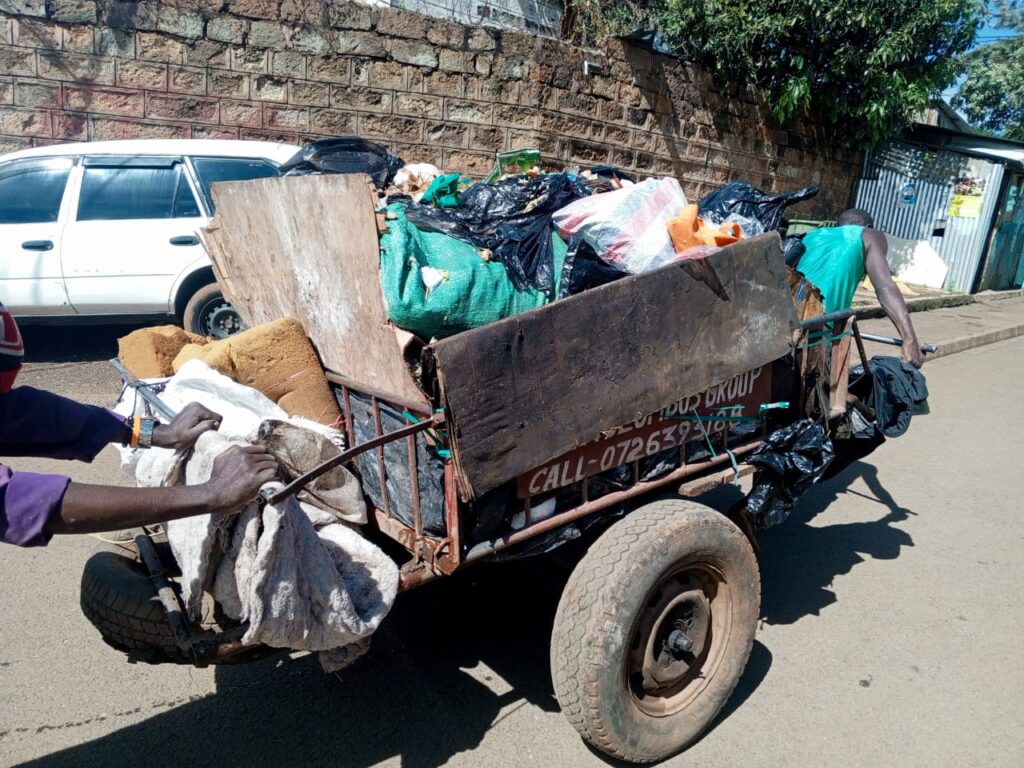By Charity Phoebe Kilei
The daily life routine, a humble yet profound scene unfolds as individuals, sported in weathered garments, traverse from one dumpsite to another with bare hands, sifting through discarded products in the hope of uncovering treasures amidst the refuse.
For many of these men and women, garbage collection has
transformed from a grim necessity into a source of livelihood; a means to meet financial obligations.
At dawn in Highrise-Kibra, the fortunate ones knock on doors to collect household trash, while the less fortunate wait amidst the remnants in landfills, seeking treasures in discarded items.
Unmistakably, within this trove of treasures lies an unexpected horror -diapers.
The sheer pile of diaper waste is staggering. Experts aver that one-month-old baby requires an estimated minimum of six diapers per day. This culminates in an annual production of about 2.2 billion diapers in Kenya.

Even though garbage collectors are generally enamored with waste, diapers prove to be a source of frustration. Recycling companies avert recycling them while citing unique processing challenges.
Erick Aosa, a 28-year-old, garbage collector in Kibra slum, shares the nightmare he faces in his line of duty.
“I am not thrilled with collecting diapers because I can’t sell them”
Daily, Aosa and his colleagues collect a chunk of disposable diapers to a dumpsite in Makina market before they are eventually transferred to Dandora.
The environmental impact intensifies on the onset of rain, as nappies become sticky and slide, exacerbating the already dire conditions.
In a tale portraying environmental degradation and hopelessness, Erick observed inadequate drainage and sanitation facilities in Kibra. Due to this, some diapers inevitably find their way into rivers and streams.
Erick desperately expressed a fervent wish for recycling companies to intercede, alluding that recycling disposable diapers has a potential market.
The majority have turned a blind eye to the effects of the aforementioned non-biodegradable product. Most women are jubilation of the impact of diapers which they said have saved them the burden of washing dirty nappies.

Christine Nafula, who birthed twins, highlights the transformative impact of disposable diapers on her life. She said this has solved her burden of daily washing routine.
“Previously, dealing with traditional nappies, particularly during rainy seasons was stressful. Diapers have simplified my routine. I however dispose of them dustbins,” she hesitantly said without worrying about their fate.
Millicent Adhiambo, a mother in Kibra with a one-year-old child, praises disposable diapers as a lifesaver in the challenging living conditions of the slum.
She said they carelessly dispose of these products with a zeal that the county government will later collect them.
Lack of proper drainage and waste facilities in the slum exacerbates the issue, and as such, this leads to streams and rivers being inundated with various types of littered garbage.
Unfortunately, despite the concerted efforts of young people in collecting and recycling garbage, diapers are often excluded from the items finding their way to recycling companies.
Brian Sigala, speaking at a climate change conference organized by the Young Women’s Christian Association (YWCA) Kenya and other stakeholders through the Voices for Just Climate Action project (VCA) supported by Hivos shed light on the limitations faced by recycling companies such as Taka Taka Solution.
He stated that they lack the technology to recycle diapers and that there is still a significant gap in including policy-making, and regulatory processes
But despite recycling approximately 90 tonnes of waste such as plastics, boxes, and organic waste, diapers are an exclusion.
On Friday, we visited the Dandora dumpsite at the request of area residents who wanted the menace highlighted.
This site receives over 2,000 tons of waste daily and it marks the central point in the waste collection narrative.
The site, which is a hub for waste pickers seeking recyclables, noted a clear indication of the broader issue of under-utilized and unmanaged waste materials across Kenya.
Just like any other dumpsite, it poses severe risks to the environment and human health, disproportionately affecting the most vulnerable in Dandora. The risks would however traverse beyond Dandora.
In Nairobi, where approximately 2,400 tonnes of solid waste are produced daily, only 45% undergoes any form of recovery or treatment. This is according to estimates by Nairobi County
Dandora, one of Africa’s largest dumpsites according to the United Nations Environmental Programme (UNEP), receives an influx of waste from the capital.
This fosters an informal recycling economy that sustains nearly 3,000 families in surrounding slums.
This informal recycling, however, comes at a significant cost; it pollutes the air, water, and soil, causing substantial health and environmental problems.
The repercussions of improper waste disposal are evident miles away from Dandora, where a pervasive stench permeates the atmosphere.
Trash of all categories, from food waste to non-recycled diapers, lies helplessly in the atmosphere, a testament to the challenges of waste management in Nairobi.
Despite being the capital, Nairobi lacks a waste sorting area, as such; this has indiscriminately exposed Dandora as the only reliable dumpsite.
Within the depths of these dumpsites and landfills, a greenhouse gas known as methane is produced under anaerobic conditions.
Experts say methane is a more potent greenhouse gas than carbon dioxide.
This volatile gas, resulting from complex chemical and biological reactions, paints a grim reality in the dumpsite.
Diapers in landfills are possible emitters of this colorless and odorless gas which contributes to environmental woe.
Various research studies have established that diapers decompose to release methane with global warming
potential 28 times greater than carbon dioxide.
The staggering environmental impact becomes even more pronounced when considering the estimated 4,000 to 7,000 single-use disposable diapers used for one baby.
According to research by the United Nations Environmental Programme, each diaper takes nearly 500 years to decompose as a result, soil and groundwater get polluted.
From ignorance occasioned by insufficient campaigns and awareness, some residents have however resorted to burning them. It is established that this however introduces additional dangers and harm to the climate.
According to a report by the United Nations Environment Programme (UNEP), methane is responsible for more than 25% of global warming.
This stark reality emphasizes the urgency of addressing methane emissions and their sources, including improper waste disposal practices.
Nairobi’s commitment to achieving carbon
neutrality by 2050 through a climate action plan reflects the city’s environmental aspirations. However, the effective management of waste, particularly concerning diapers, emerges as a critical component for the city to realize this ambitious goal.
There is an urgent need for transformative changes in how we handle waste. The consequences of unbridled waste generation have far-reaching environmental implications, and the call for systemic adjustments in waste disposal practices becomes increasingly apparent.
The narrative intertwines threads of environmental impact, social responsibility, and economic sustainability, urging us to embark on a comprehensive re-evaluation of our global approach to waste management.
As the world confronts the repercussions of unsustainable waste practices and accelerated impacts of climate change, the imperative to adopt sustainable solutions has never been more crucial. As Africa sets its sights on COP 28 in the UAE, we anticipate that the conference will emphasize concrete resolutions for the environmentally sound management of waste.
